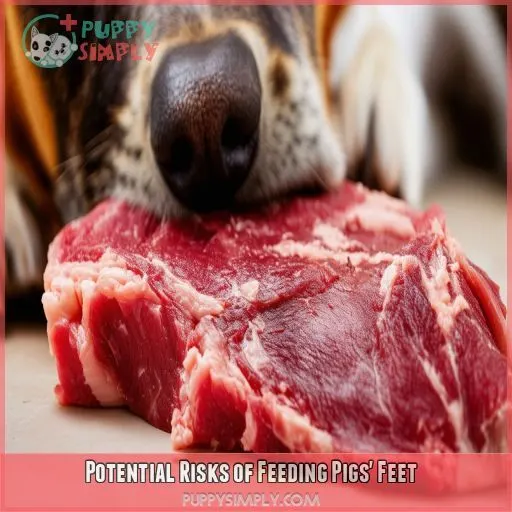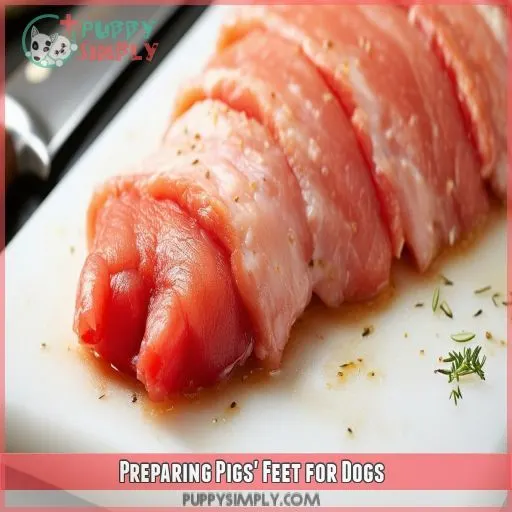This site is supported by our readers. We may earn a commission, at no cost to you, if you purchase through links.
 Ever wondered if your canine companion can safely enjoy pigs’ feet?
Ever wondered if your canine companion can safely enjoy pigs’ feet?
As a dog owner, you’re always looking for nutritious treats, but safety comes first.
Can dogs eat pigs feet? The answer isn’t straightforward.
While pigs’ feet can offer nutritional benefits, they also pose potential risks.
This article reveals the shocking truth about feeding pigs’ feet to dogs and provides 5 essential safety tips.
You’ll learn how to prepare them properly, introduce them to your dog’s diet, and explore safer alternatives if needed.
Table Of Contents
- Key Takeaways
- Can Dogs Eat Pigs Feet?
- Can Dogs Eat Pigs’ Feet?
- Nutritional Value of Pigs’ Feet
- Potential Risks of Feeding Pigs’ Feet
- Preparing Pigs’ Feet for Dogs
- How to Introduce Pigs’ Feet to Dogs
- Alternatives to Pigs’ Feet
- Fermented Raw Pig Feet for Dogs
- Safety First With Pigs’ Feet
- Preparation & Serving Tips for Dogs
- Potential Risks & Alternatives
- Frequently Asked Questions (FAQs)
- How do you prepare pig’s feet for dogs?
- Can I feed my dog raw pig’s feet?
- Can dogs eat raw pig trotters?
- What part of pigs feet are edible?
- How often can dogs safely eat pigs feet?
- Are pigs feet suitable for puppies or senior dogs?
- Can pigs feet help with bad dog breath?
- Do different dog breeds tolerate pigs feet differently?
- Are there any seasonal considerations when feeding pigs feet?
- Conclusion
Key Takeaways
- Pigs’ feet can be a tasty treat for dogs, but it’s not all sunshine and rainbows – they come with potential risks like choking hazards and bacterial contamination. Think of it as a culinary tightrope walk for your furry friend!
- Preparation is key – cook those trotters thoroughly to kick harmful bacteria to the curb. Your pup might give you puppy eyes for raw pig feet, but don’t cave in. Safety first, drool second!
- Moderation is the name of the game. Pigs’ feet are like that rich uncle who visits occasionally – fun in small doses, but you wouldn’t want them moving in. Treat them as just that – a treat, not a dietary staple.
- When in doubt, consult your vet. They’re like the Yoda of pet nutrition – wise, knowledgeable, and probably with better grammar. They can help you navigate the murky waters of pigs’ feet for your particular pooch.
Can Dogs Eat Pigs Feet?
Can dogs eat pigs feet? Yes, but with caution.
While pigs’ feet offer nutritional benefits like protein and collagen, they also pose risks.
Choking hazards, splintering bones, and harmful bacteria are primary concerns.
To safely feed your furry friend pigs’ feet, cook them thoroughly to eliminate bacteria and chop them into manageable pieces.
Start with small amounts and monitor for any adverse reactions.
Always consult your vet before introducing new foods to your dog’s diet.
By following proper preparation and serving guidelines, you can minimize risks and maximize benefits.
Let’s explore the ins and outs of this canine delicacy.
Can Dogs Eat Pigs’ Feet?

You’ve probably wondered if those pig feet at the butcher’s could be a tasty treat for your furry friend.
While pigs’ feet can be a safe snack for dogs, there are some important things to think about.
First off, if your pup has a pork allergy, it’s a definite no-go.
For others, these bone-in chews can be a vet-approved option that supports joint health.
But hold your horses! Raw dog food enthusiasts, take note: raw pig feet are off the menu due to bacterial risks.
Cooked pigs’ feet, however, can be a delightful addition to your dog’s treat repertoire.
Just remember, moderation is key.
Like any new dog treat, introduce pig feet slowly and watch for any adverse reactions.
Your pooch’s safety comes first, so always consult your vet before diving into new treats.
Nutritional Value of Pigs’ Feet
Now that we’ve established whether dogs can eat pigs’ feet, let’s sink our teeth into their nutritional value. You might be surprised to learn that these seemingly humble treats pack quite a punch in the nutrition department. Pigs’ feet are a goldmine of protein, which is essential for your furry friend’s muscle development and overall health. But that’s not all – they’re also rich in collagen, a superstar nutrient that supports joint health and mobility. Think of collagen as nature’s WD-40 for your dog’s joints!
These tasty morsels also contain omega-3 fatty acids, which contribute to a glossy coat and healthy skin. In terms of crude protein and crude fat content, pigs’ feet deliver a balanced nutritional profile. They’re like a multivitamin wrapped in a meaty package that your dog will love. Who knew these trotters could trot out such impressive benefits?
Potential Risks of Feeding Pigs’ Feet
While pigs’ feet can offer nutritional benefits, they’re not without risks. You’ll want to be aware of potential hazards before treating your furry friend. Choking is a serious concern, especially for smaller dogs or those who gulp their food. The bones can splinter, posing a dangerous threat to your pup’s digestive tract.
Bacteria is another worry. Factory-farmed pigs may carry harmful pathogens, so proper handling and cooking are essential. Some dogs might’ve pig allergies, leading to uncomfortable reactions. Even without allergies, pigs’ feet can be tough on digestion, potentially causing upset stomachs or worse.
Don’t forget about parasites! These unwelcome guests can hitch a ride on improperly prepared pigs’ feet. Always check the guaranteed analysis of any commercial pig feet products to make sure they’re safe for your pooch. Remember, your dog’s safety is top priority!
Preparing Pigs’ Feet for Dogs
Now that you’re aware of the risks, let’s get into preparing pig trotters for your furry friend.
It’s important to cook them thoroughly to kill any bacteria. You’ve got options: boiling or roasting work well.
If you’re boiling, toss out that fatty water afterward. For an extra nutritional boost, throw some veggies into the pot.
Once cooked, chop ’em up into manageable pieces to prevent choking hazards.
Store leftovers in the fridge for up to three days, but don’t let them overstay their welcome.
When serving, moderation is key. These protein-packed morsels pack a caloric punch, so don’t go overboard.
If you’re considering a raw diet, hold your horses – raw pig trotters are a no-go for dogs.
How to Introduce Pigs’ Feet to Dogs
Ready to introduce pigs’ feet to your furry friend? Here’s how to safely make pigs’ feet a part of your dog’s treat time:
- Start small: Offer a tiny piece of cooked pigs’ foot and watch for any adverse reactions.
- Monitor closely: Keep an eye out for signs of digestive upset, like vomiting or diarrhea.
- Gradually increase: If all goes well, slowly up the amount over time.
- Treat, don’t feast: Remember, pigs’ feet are treats, not a meal replacement.
Pigs’ feet can be a novel protein source, perfect for dogs on an elimination diet or those exploring raw feeding options. They’re packed with joint-health boosters like glucosamine and chondroitin. But don’t go hog-wild! Safe feeding practices are key. Stick to pastured pigs’ feet for the best quality. With patience and care, you’ll have your pup doing the "piggy dance" for these tasty morsels in no time!
Alternatives to Pigs’ Feet
If you’re looking for alternatives to pigs’ feet, you’ve got plenty of options to keep your furry friend happy and healthy. Beef tendons, chicken feet, and bully sticks are excellent choices that provide similar benefits. These treats are tasty but also support your dog’s joint health, just like pigs’ feet.
For a more adventurous approach, consider:
- Raw bones from heritage breeds
- Homemade bone broth for added nutrients
- Air-dried dog treats for a convenient option
Don’t forget to explore frozen food options and try your hand at homemade dog recipes. These alternatives can offer the same nutritional benefits as pigs’ feet while adding variety to your pup’s diet. Remember, it’s important to introduce new treats gradually and monitor your dog’s reaction. By offering a diverse range of treats, you’ll keep your canine companion excited and satisfied while ensuring their overall health and well-being.
Fermented Raw Pig Feet for Dogs
While alternatives to pigs’ feet exist, some dog owners opt for fermented raw pig feet. These treats offer a unique twist on the traditional option. Fermentation introduces beneficial bacteria, potentially aiding your dog’s digestion and oral health. You’ll find these products made from single-ingredient, grass-fed meats without additives or preservatives. They’re packed with protein and good fats, supporting your furry friend’s overall health.
But hold your horses! Before diving in, consider the risks. Raw pig parts can harbor dangerous bacteria. You’ll need to handle them carefully, keeping them separate from other foods and washing surfaces thoroughly. Store them frozen and thaw in the fridge for safety. Remember, moderation is key. While fermented raw pig feet can be a tasty treat, they shouldn’t replace a balanced diet. Always consult your vet before introducing new foods to your dog’s menu.
Safety First With Pigs’ Feet
Safety is key when feeding your furry friend pigs’ feet.
These treats, while tasty, can pose potential risks if not handled properly.
Choking hazards are a real concern, especially for smaller dogs who might bite off more than they can chew.
While pigs’ feet can contribute to bone health, they can also harbor dangerous bacteria if not sourced from reputable meat packing plants.
Always cook pigs’ feet thoroughly to eliminate any bacterial risks – this isn’t the time for a raw diet!
They require special care and consideration.
Can dogs eat pigs’ feet? Yes, but with caution.
It’s important to weigh the benefits against the potential dangers.
When in doubt, consult your vet for specific advice on incorporating these treats into your pup’s diet.
Preparation & Serving Tips for Dogs
Now that you’re aware of the safety precautions, let’s get into preparing and serving pigs’ feet to your furry friend. Cooking these treats right is important for your dog’s health. Here are four essential steps to follow:
- Boil the pigs’ feet to remove excess fat and soften the meat.
- Remove any small bones that could pose a choking hazard.
- Cut the cooked pigs’ feet into appropriate serving sizes based on your dog’s weight.
- Store leftovers in an airtight container in the fridge for up to three days.
Potential Risks & Alternatives
While Pigs’ Feet can be a tasty treat for your furry friend, they come with potential risks you shouldn’t ignore. Choking Hazard is the top concern, especially for smaller dogs or those who gulp their food. Don’t let your pup become a statistic! Raw Bones pose a Bacterial Risk, so always cook them thoroughly. But don’t worry, there are plenty of Safe Treats to keep your dog’s tail wagging:
- Cooked chicken bones (never raw!)
- Crunchy carrots for dental health
- Peanut butter (xylitol-free) for a protein boost
Frequently Asked Questions (FAQs)
How do you prepare pig’s feet for dogs?
To prepare pig’s feet for dogs, thoroughly cook them by boiling or roasting. Remove any bones, trim excess fat, and avoid seasoning. Cut into appropriate sizes for your dog’s breed. Always supervise feeding and introduce gradually to prevent digestive issues.
Can I feed my dog raw pig’s feet?
Like playing with fire, feeding raw pig’s feet to your dog is risky. They can harbor harmful bacteria. Always cook pig’s feet thoroughly to eliminate pathogens. It’s safer to offer cooked versions as an occasional treat.
Can dogs eat raw pig trotters?
You shouldn’t feed your dog raw pig trotters. They’re a choking hazard and may contain harmful bacteria. Always cook them thoroughly to eliminate risks. If you’re unsure, consult your vet for safe treat alternatives.
What part of pigs feet are edible?
Pigs’ pedicures provide plenty of palatable parts! You can consume the skin, fat, connective tissue, and meat around the bones. The trotters’ tender tissue offers tasty tidbits, but you’ll want to avoid ingesting any actual bones for safety’s sake.
How often can dogs safely eat pigs feet?
You can safely offer your dog pigs’ feet as a treat once or twice a week. Make sure they’re fully cooked and given in moderation. Monitor your pup’s reaction and adjust frequency based on their individual tolerance and health needs.
Are pigs feet suitable for puppies or senior dogs?
Imagine your 12-year-old Labrador, Max, watching a pig’s foot with interest. While pigs’ feet can be a treat for adult dogs, they’re not ideal for puppies or seniors. You’ll want to think about softer, easily digestible options for these age groups.
Can pigs feet help with bad dog breath?
Pigs’ feet can potentially help with bad dog breath, but they’re not a cure-all. Their chewy texture may reduce plaque buildup, while the fermentation process in some products introduces beneficial bacteria that could improve oral health.
Do different dog breeds tolerate pigs feet differently?
Yes, different dog breeds can tolerate pigs’ feet differently. Larger breeds often handle them better, while smaller dogs may struggle. Your pup’s size, health, and individual digestive system all play a role in how they’ll react to this treat.
Are there any seasonal considerations when feeding pigs feet?
You’ll want to keep in mind seasonal factors when feeding pigs’ feet to your dog. In summer, they’re more prone to spoilage, so refrigerate promptly. During winter, they can provide extra calories to help maintain body heat.
Conclusion
The question "can dogs eat pigs feet" doesn’t have a simple answer.
While they offer nutritional benefits, pigs’ feet also pose potential risks.
By following proper preparation techniques and safety guidelines, you can minimize these risks.
However, it’s important to introduce pigs’ feet gradually and monitor your dog’s reaction.
If you’re unsure, consult your veterinarian or consider safer alternatives.













